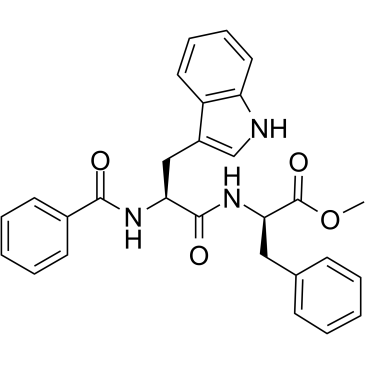| Cas No.: | 1435265-06-7 |
| Chemical Name: | Methyl (2R)-2-[[(2S)-2-benzamido-3-(1H-indol-3-yl)propanoyl]amino]-3-phenylpropanoate |
| Synonyms: | HCH6-1;HCH6 1;HCH61 |
| SMILES: | O=C([C@]([H])(C([H])([H])C1=C([H])N([H])C2=C([H])C([H])=C([H])C([H])=C12)N([H])C(C1C([H])=C([H])C([H])=C([H])C=1[H])=O)N([H])[C@@]([H])(C(=O)OC([H])([H])[H])C([H])([H])C1C([H])=C([H])C([H])=C([H])C=1[H] |
| Formula: | C28H27N3O4 |
| M.Wt: | 469.53 |
| Purity: | >98% |
| Sotrage: | 2 years -20°C Powder, 2 weeks 4°C in DMSO, 6 months -80°C in DMSO |
| Publication: | [1]. Yang SC, et al. Dipeptide HCH6-1 inhibits neutrophil activation and protects against acute lung injury by blocking FPR1. Free Radic Biol Med. 2017 May;106:254-269 |
| Description: | HCH6-1 is a competitive antagonist of Formyl peptide receptor 1 (FPR1), inhibits superoxide anion generation, elastase release, and chemotaxis in human neutrophils activated by fMLF (an FPR1 agonist). HCH6-1 can be used to treat neutrophilic inflammatory disease due to its inhibitory effects in neutrophil-like cells[1]. |
| References: | [1]. Yang SC, et al. Dipeptide HCH6-1 inhibits neutrophil activation and protects against acute lung injury by blocking FPR1. Free Radic Biol Med. 2017 May;106:254-269 |

 To enhance service speed and avoid tariff delays, we've opened a US warehouse. All US orders ship directly from our US facility.
To enhance service speed and avoid tariff delays, we've opened a US warehouse. All US orders ship directly from our US facility.




















